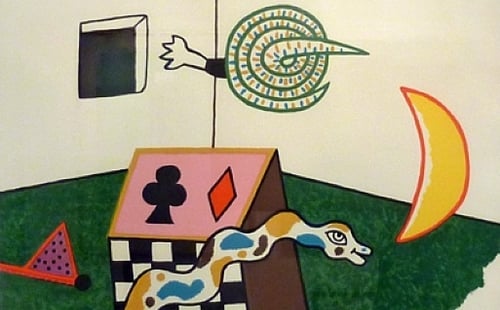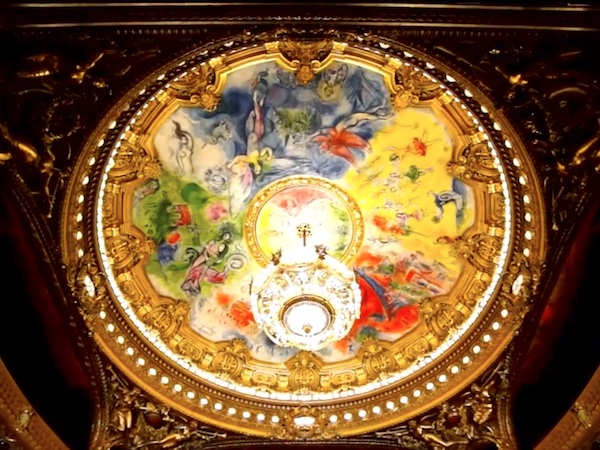Art & Exhibitions
The Essentials: Resale Royalties Fight, Hans Ulrich Obrist’s Curating Tips, and More
Plus rediscovering Alan Davie, how to ship antiquities, and the Scottish art market.

Plus rediscovering Alan Davie, how to ship antiquities, and the Scottish art market.

Benjamin Sutton


Marc Chagall’s painting on the ceiling of the Opéra Garnier in Paris.
Photo: Vimeo screengrab.
The Interview: In the 1950s the Scottish-born, London-based painter Alan Davie may have been Britain’s most celebrated artist, his vigorous Abstract Expressionist compositions rivaling those of his American contemporaries, but since the 1970s he has completely disappeared from the contemporary art scene. Now, at age 93, he’s in the midst of a late-career comeback, partly thanks to an upcoming show at Tate Britain. “Really I need the whole of the Tate to show my work,” he tells the Telegraph’s Mark Hudson in a fascinating profile. “One display isn’t enough.”
The Opinion Piece: The Serpentine Gallery’s Hans Ulrich Obrist—who, much like Chev Chelios, Jason Stratham’s character in the action film franchise Crank, seems to need to keep curating in order to go on living—reflects on the role of the curator in the Guardian. “Today, curating as a profession means at least four things,” he writes. “It means to preserve, in the sense of safeguarding the heritage of art. It means to be the selector of new work. It means to connect to art history. And it means displaying or arranging the work. But it’s more than that.” In the same article, Taryn Simon, David Shrigley, John Baldessari, and others reflect on favorite exhibitions they’ve seen.
The Controversy: As lawmakers in the United States Congress consider resale royalties legislation for visual artists, those whose business might be most affected by the law’s passage—Sotheby’s and Christie’s—have spent about $1 million to date on anti-resale royalties lobbying in Washington, D.C. “We’re taking it seriously, even though we don’t think it’s going to pass,” Jane A. Levine, director of worldwide compliance at Sotheby’s, tells the New York Times.
The Review: “There’s plenty to dislike about this wildly uneven, often frustrating selection of alternative American art,” the Village Voice’s Christian Viveros-Fauné writes in his belated but decidedly upbeat review of the 2014 Whitney Biennial. “But after a couple of visits, I’m convinced that this version of ‘the show everyone loves to hate’—it has long presented a feckless parade of in-crowd and market favorites—deserves an extra dose of optimism, or at least the benefit of the doubt.” Read our Critical Reduction of 2014 Whitney Biennial reviews here.
The Preview: As the Stedelijk Museum’s Mike Kelley retrospective gets set to open in the late artist’s longtime hometown of Los Angeles, at the Museum of Contemporary Art, LA Times critic Christopher Knight takes a long look at Kelley’s career and some key works from the show. “Two sides of life are visible in the work he made during a three-decade career,” Knight writes. “One is childhood, a not-so-innocent time represented by toys. The other is maturity, the world of adult responsibilities and sobriety embodied in any serious art.”
The Behind-the-Scenes Feature: In a fascinating glimpse at the nuts and bolts of shipping antiquities, one written in French, Le Soleil’s Isabelle Houde followed a collection of some 160 ancient Greek sculptures on their journey—from packing and crating to the supervised trans-Atlantic flight—between Berlin’s Antikensammlung and the Musée de la civilisation in Quebec, where they will be the centerpieces of the exhibition “Les maîtres de l’Olympe” opening next month.
The Feature: Between Scotland’s looming referendum for independence in September, and Glasgow hosting the Commonwealth Games in July, the Financial Times takes a long look at the contemporary Scottish art market. “There still isn’t enough of a market here to support us solely,” says Edinburgh-based dealer Richard Ingleby. “The bulk of our business is in England and overseas—but I would stress we do have some very good Scottish collectors.”
The Study: A newly published multi-generational study comparing the average incomes of parents and their children in the US based on their professions found, perhaps unsurprisingly, that people who fall into the “designers, musicians, artists, etc.” bracket fare the worst compared to their parents.
The List: Jonathan Jones picked his 10 greatest artworks of all time and, surprise, all the works that are attributed to a specific artist are by men. Jones praises a predictable cast of ancient, Renaissance, and modern males, from Leonardo da Vinci and Michelangelo up through Diego Velázquez, Pablo Picasso, and Jackson Pollock. Another win for the patriarchy!
The WTF: In an apparent riff on the popular Tumblr project Beyonce Art History, and timed to the tenth anniversary of Usher’s classic song “Confessions,” Complex came up with a slideshow of “20 Pieces of Art Made Better by Usher’s ‘Confessions,’” culminating in an Usher-ized version of Edvard Munch’s “The Scream.”
The Extra WTF: Something called Laser Cat, a sort of crowd-sourced art exhibition and feline video art projection, will be the grand finale of the ADC Festival of Art + Craft in Advertising and Design in Miami Beach next month. The project was conceived by the duo of Dave Glass and Kill Cooper—collectively known as Hungry Castle. “Laser Cat is a giant cat that projects art,” Glass told the Huffington Post. “He’s gonna be the first cat to project people’s art on Miami Beach. We’ve received 10,000 artworks from people all over the world so far, including sculptures, videos, paintings, cat photos, and more.”
The Eye Candy: Proving that drones needn’t be used exclusively by secretive government agencies bent on maintaining their nation’s most cherished principles through means that violate those very same principles, the group Freeway Drone piloted a small aircraft around Paris’s Opéra Garnier, filming stunning aerial views of the Marc Chagall painting that adorns its ceiling.
The Extra-Curricular: In light of the astronomic success of Netflix, countless other industries are turning to internet-based subscription systems, from music and magazines to newspapers and books. Though the Globe and Mail’s in-depth survey of subscription-based online businesses doesn’t touch on how that model might be applied to visual art, the possibilities are well worth pondering. “Still, the jury is out on whether the new economics will help or hurt those actually producing the content,” the Globe’s Simon Houpt writes. “Over the past couple of years, musicians have waged a high-profile battle against services such as Pandora, Rdio and Spotify, with photos of their infinitesimal royalty checks posted to social-media sites.”